
| Addiction Research Unit |
| Department of Psychology/University at
Buffalo |
|
Before Prohibition:
Images from the preprohibition era when
many psychotropic substances
were legally available in America and
Europe
Many of the substances prohibited today were legally available in the past.
This small exposition contains samples of the many psychoactive medicines widely
available during the late-19th century through the mid-20th century. Some of the
pictures are oversized to improve legibility. Additional photographs are
available for some products in the author's private collection. For a quick
comparison with current drug regulations, see Drug
Schedules.
| Note: Most contemporary pharmaceutical manufacturers and
several spice companies produced products containing potent psychoactive
compounds like opium. Some of these companies are prominent companies
today manufacturing and distributing well-known consumer products. The
incorporation of potent psychoactive substances in a company's product
line was common practice during the 19th and early 20th centuries. This
was before the deleterious effects of habitual use of these substances was
widely recognized. |
Background
The prohibition of psychoactive substances has evolved
gradually in the United States and in Europe. The opium-containing preparation
#laudanum">laudanum had
been widely available since the 18th century. Morphine, cocaine, and even heroin
were seen as miracle cures when they were first discovered. During the mid to
late 19th century, many manufacturers proudly proclaimed that their products
contained cocaine or opium. A few, like Mrs. Winslow's
Soothing Syrup for infants which contained morphine, were more guarded
in divulging their principle ingredients. By the beginning of the 20th century,
problems with habitual use of cocaine and opiates were becoming increasingly
apparent. This lead to the removal of these substances from some products (e.g.,
Coca Cola) and to the introduction of the Pure Food and Drug Act (1906)
in the United States which required the listing of ingredients on product
labels. Nonetheless, standard narcotic remedies like paregoric
remained readily available into the early 20th century, and Benzedrine inhalers
were marketed without prescription until the early 1950s. Codeine wasn't removed
from most over-the-counter cough suppressants until the early 1980s.
Cocaine-Containing Products
There were three types of medicines often
containing cocaine--topical anesthetics such as toothache powders, catarrh
medicines for relieving head and chest congestion, and medicinal (probably also
recreational) cocaine-containing wines advocated for their numerous beneficial
effects.
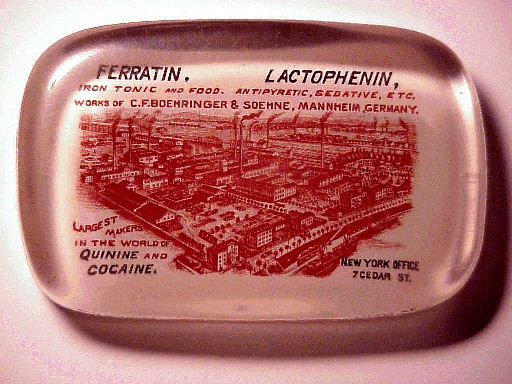
| Paperweight advertisement for C.F. Boehringer & Soehne
(Mannheim, Germany), "largest makers in the world of quinine and cocaine."
This chemical manufacturer was proud of its leading position in the
world's cocaine market. |
|
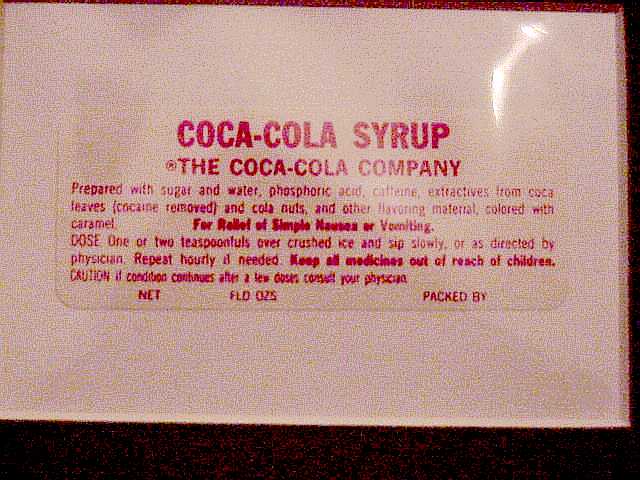
| Early Coca-Cola syrup label listing ingredients. Even after the
cocaine was removed from the coca leaves used to make Coca Cola (c. 1906),
the product was still sold for its medicinal effects. Today the company
generally refuses to comment on the use of coca leaves in their
product. |
|
Cocaine-containing topical anesthetics
Cocaine is an effective local
anesthetic, and some of the earliest uses of cocaine was for its local
anesthetic properties. Today, other compounds such as lidocaine and procaine are
the medically preferred local anesthetics. These compounds do not produce the
mood-elevating and euphorigenic "side effects" that can occur with cocaine.
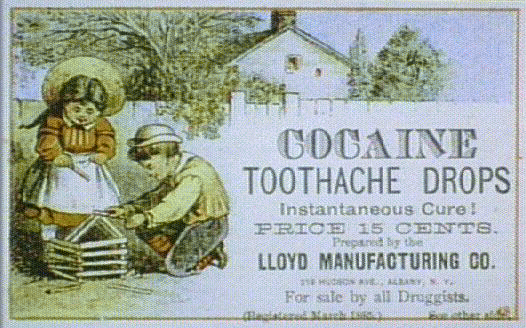
| Cocaine toothache drops were popular with children and with
their parents. Not only would the medicine numb the pain, but it could
also put the user in a "better" mood. |
|

| Cocaine-containing throat lozenges, "indispensable for singers,
teachers, and orators." In addition to quieting a sore throat, these
lozenges undoubtedly provided the "pick-me-up" to keep these professionals
performing at their peak. This box of lozenges is from a Belgium pharmacy
(c. 1900). Local pharmacies often bought their drugs in bulk and packaged
them for consumers under their own labels. |
|
Cocaine-containing wines
There were many companies competing in the
lucrative coca-wine
market. Vin Mariani is the most recognized and perhaps the most popular
at the time, but many other brands were produced in the United States and
abroad.

| Metcalf's Coca Wine was one of a large number of
cocaine-containing wines available on the market. All claimed medicinal
effects, although they were undoubtedly consumed for their "recreational"
value as well. |
|
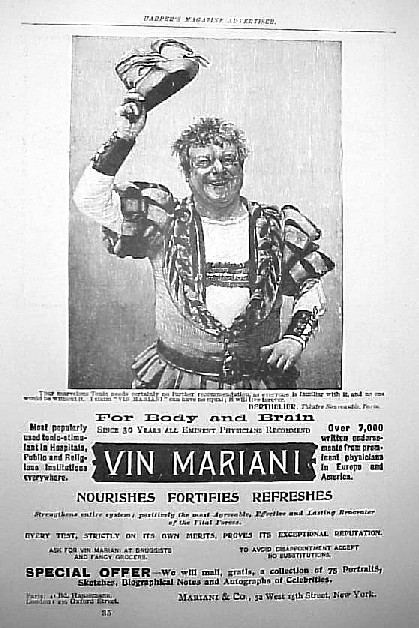
| Vin Mariani was the leading coca wine. This advertisement
features an endorsement from Berthelier, a popular late 19th century
actor. The caption immediately below the photograph reads, "Your marvelous
Tonic needs certainly no further recommendation as everyone is familiar
with it, and no one would be without it. I claim 'VIN MARIANI' can have no
equal; it will live forever." The caption also proclaims "over 7,000
written endorsements from prominent physicians in Europe and America" and
that the product has had acclaim for 30 years. (From Harper's
Magazine, March, 1894.) |
|

| This coca wine was made by the Maltine Manufacturing Company
(New York). The dosage indicated on the back of the bottle reads: "A wine
glass full with, or immediately after, meals. Children in proportion."
Malt extract was taken for its health-promoting effects and alcohol was
considered by many to have medicinal effects. It's not surprising to see
the 'virtues' of these three "medicines" combined into a single
product. |
|

| In addition to curing the usual ailments coca wine was claimed to
remedy, Bullard & Shedd's brand of coca wine claimed to be
effective in curing sea sickness. It was also promoted to cure the "opium
or alcohol habit." |
|

| Burnett's Cocoaine (c. 1880) contained coconut oil not cocaine
as its primary ingredient. Hoping to capitalize on the popularity of
products containing cocaine and their association with "modern medicine,"
some manufacturers developed similarly sounding proprietary names.
Burnett's Cocoaine bottles are bought and sold by many modern collectors
who mistakenly believe the product contained cocaine. They must be
similarly confused about the nature of "cocoa" and "coca" products.
("Cocoanut" is also a variant spelling of "coconut," and hence the aptly
named product.) |
|
Opiate-Containing Products
Opiate-based formulations were probably even
more widely employed than those containing cocaine. Laudanum had been in use for
over two centuries, and the isolation of morphine in the early 19th century (c.
1803/1817) and the later development of heroin (c. 1898) were lauded as even
more effective remedies.
Modern authors usually suggest that widespread opium use was a major health
problem during the 19th century. However, the use of opiates must be kept in
proper perspective with other contemporary health problems. Mortality from
cholera, malaria, and dysentery was very high, and opiates provided some relief
from these illnesses (Opiates remain the most effective treatment for
dysentery.). Some authors have suggested that the easy availability of
opiate-based medicines saved more lives than it took. As the deleterious effects
of chronic opiate use became increasingly recognized during the late 19th
century, several factors helped ease the need for opiates: the improvements in
sanitation diminished cholera and dysentery, the drainage of swamp lands
decreased malaria, and the introduction of acetylsalicylic acid (aspirin; 1899)
provided an alternative medicine for moderate pain relief.
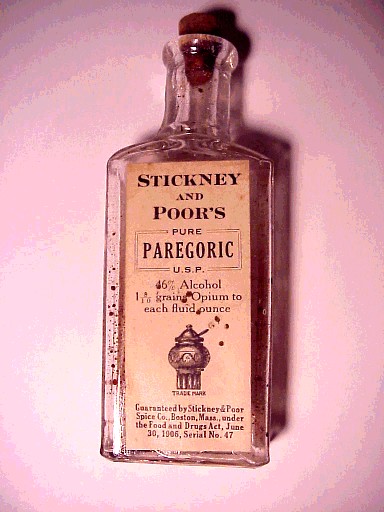
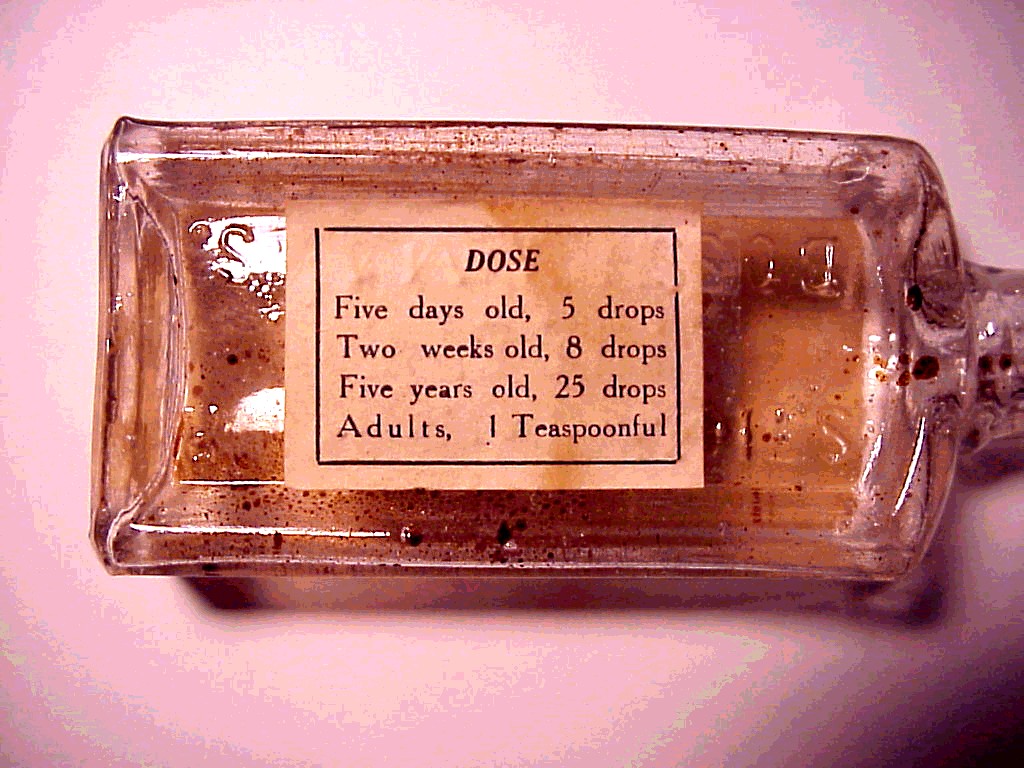
| This bottle of Stickney and Poor's paregoric
was distributed much like the spices for which the company is better
known. McCormick also manufactured and sold paregoric, which is a mixture
of opium and alcohol. Doses for infants, children, and adults are given on
the bottle. At 46% alcohol, this product is 92 proof which is pretty
potent in itself. |
|
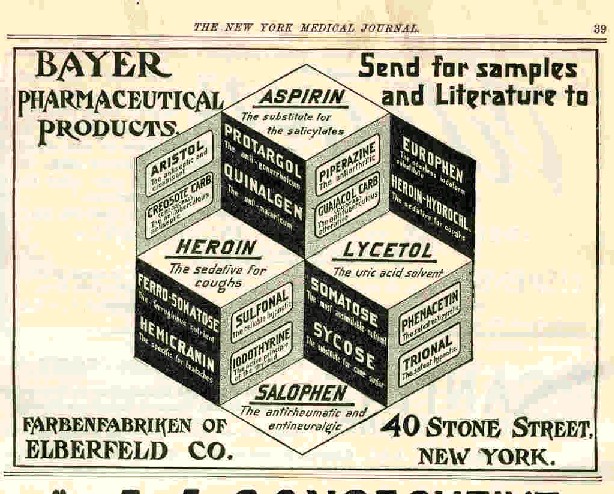
| Heroin was commercially developed by Bayer Pharmaceutical and
was marketed by Bayer and other companies (c. 1900) for several medicinal
uses including cough suppression. |
|
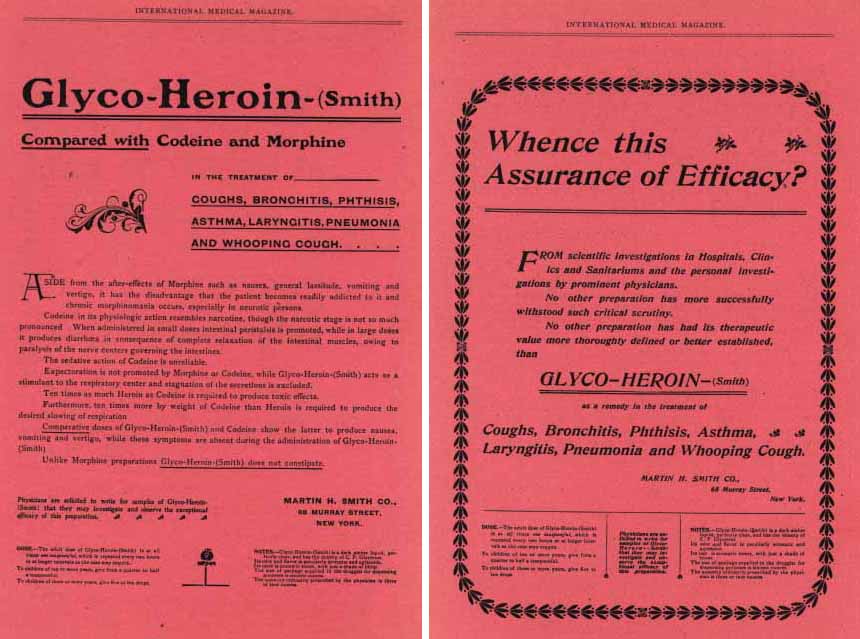
| This magazine advertisement is for Glyco-Heroin manufactured by
Martin H. Smith Company (New York). Heroin was widely used not only as
an analgesic but also as a remedy for asthma, coughs, and pneumonia.
Mixing heroin with glycerin (and often adding sugar or spices) made the
bitter-tasting opiate more palatable for oral consumption. (From
International Medical Magazine, January, 1902.) |
| |
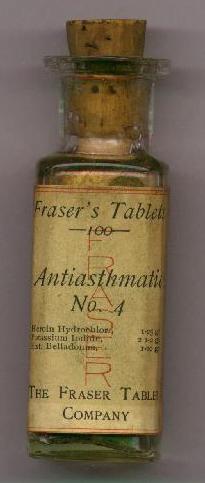
| These Heroin tablets manufactured by The Fraser Tablet Company
were marketed for the relief of asthma. |
|
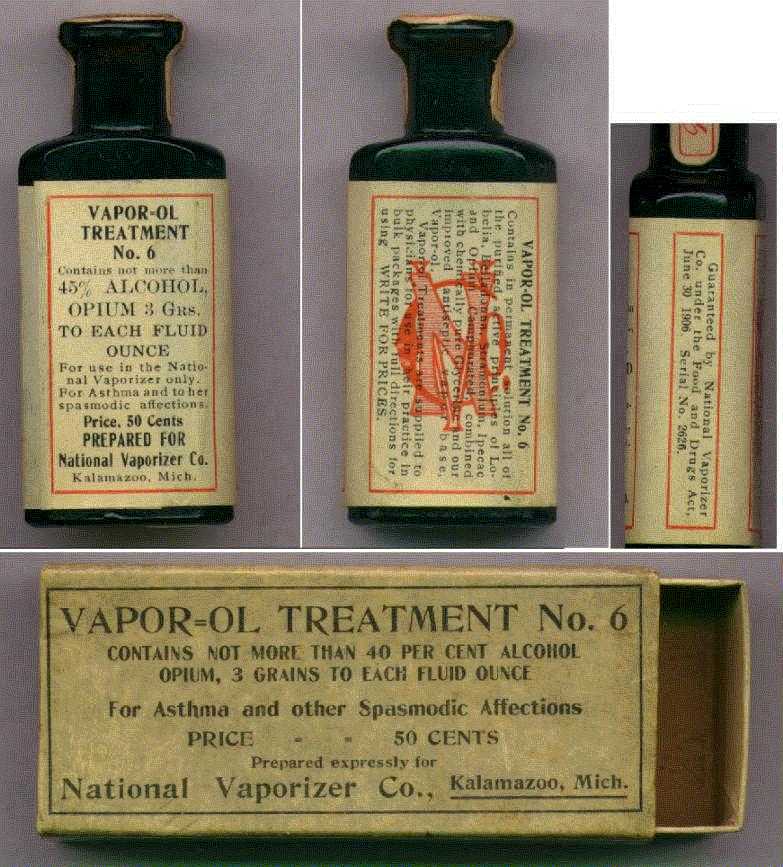
| This National Vaporizer Vapor-OL (opium) Treatment no. 6 for
asthma may have provided a unique method of essentially "smoking"
opium. The volatile liquid was placed in a pan that was heated by a small
kerosene lamp (see below). Other substances were also used in these early
(c. 1890) vaporizers, but this mixture probably ensured plenty of visitors
for the spasmodically affected. |
|
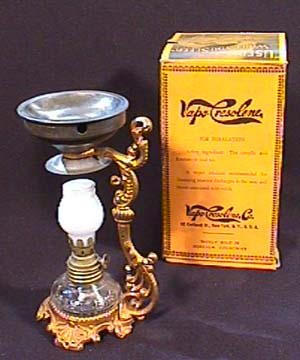
| Vapo-cresolene lamps were marketed primarily to vaporize
creosol-based products for the relief of head and chest congestion.
However, they were also used with other products such as the opium-based
asthma medicine shown above. |
|
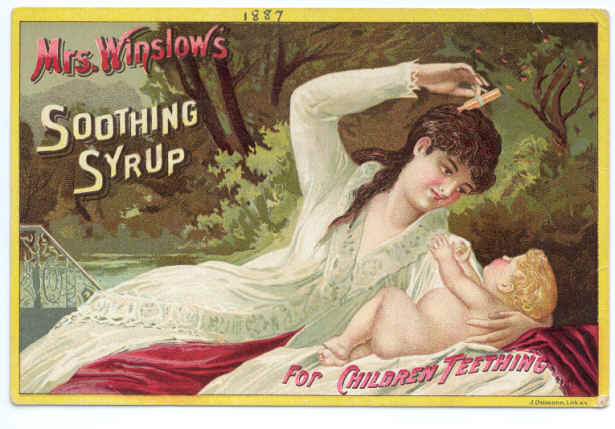
| Mrs. Winslow's Soothing Syrup was an indispensable aid to
mothers and child-care providers. Containing one grain (65 mg) of morphine
per fluid ounce, it effectively quieted restless infants and small
children. It probably also helped mothers relax after a hard day's work.
The company used various media to promote their product, including recipe
books, calendars, and trade cards such as the one shown here from 1887 (A
calendar is on the reverse side.). |
|

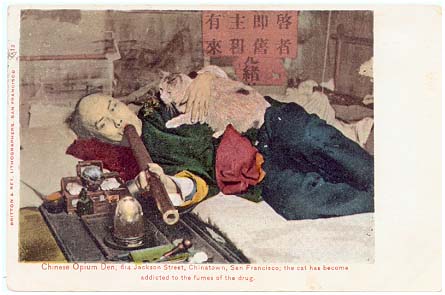
| Opium smoking was another common method of administering opium.
Although often associated with the Chinese, opium smoking was much more
widespread and especially popular with some affluent occidentals. Various
media, such as this postcard from San Francisco (c. 1900), encouraged the
popular stereotype. In addition to the "recreational" effects produced by
smoked opium, certain medicinal effects were also produced. These effects
were similar to those produced by Glyco-heroin, paregoric, and other
opiate-containing medications. (cf. Vapo-OL [opium] Treatment no. 6 for
asthma illustrated above.) |
|
Amphetamine-Containing Products
Amphetamine was synthesized too late to
have the widespread applications enjoyed decades earlier by cocaine and the
opiates. It was, however, marketed in products commonly used to relieve head
congestion and asthma. Amphetamine continued to be employed as a popular
prescription diet-aid into the 1970s.
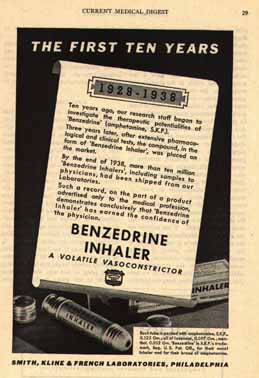
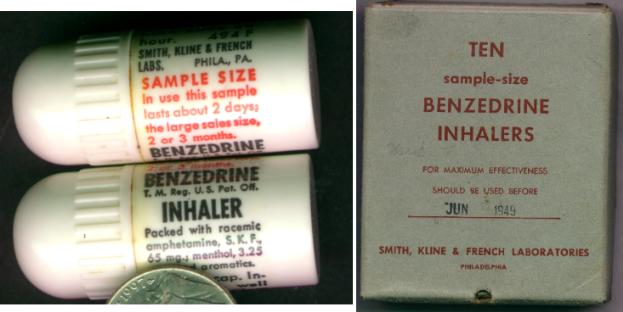
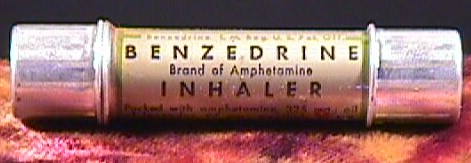
| Benzedrine (racemic amphetamine) inhalers were available
over-the-counter until the early 1950s. Some airlines even gave them out
to passengers to minimize discomfort when the plane was landing and taking
off. The Smith, Kline, and French advertisement proudly proclaims that
over 10 million Benzedrine inhalers had been shipped by 1938, only 7 years
after the product's introduction. This may have even outpaced McDonald's
hamburger sales during their early expansion (Remember the "over x million
hamburgers sold" signs on the golden arches?). |
|
Common Formulations
for early psychoactive
medicines
For some products, such as coca wine, the
formulations varied considerably across manufacturers. Other products also
showed variations (e.g. alcohol content for paregoric ranged between 18% and
46%), but USP standardization later ensured consistent formulations among
chemists and commercial manufacturers. Because opium is a natural product, early
formulations using opium would have a variable opiate content, depending on
growing and refining conditions (generally, opium contained 6 to 12% morphine).
Later opium formulations were more consistent as chemical assays ensured more
consistent opiate content.
Some Early Medicines with
Psychoactive Ingredients
| coca wine |
30 grains Erythroxylum coca per ounce of wine |
| laudanum |
45% alcohol with 45.6 grains opium (2.964 grams) per fluid ounce
(equivalent to around 296 mg morphine per ounce) |
| Mrs. Winslow's Soothing Syrup |
1 grain (65 mg) morphine per fluid ounce |
| paregoric |
camphorated 46% alcohol with 1.8 grains opium (117 mg) per fluid ounce
(equivalent to around 11.7 mg morphine) |























